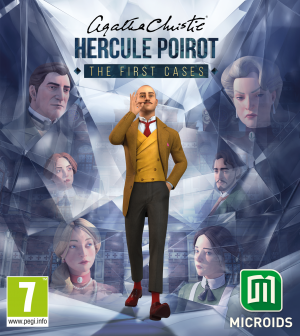Review for Agatha Christie – Hercule Poirot: The First Cases

Agatha Christie’s Hercule Poirot has had a spotty record when it comes to making the jump from book page to interactive adventure, but Blazing Griffin Games hopes to change that by going all the way back to the start of the great Belgian detective’s career. The First Cases sees Poirot trapped in an isolated manor, where he must investigate theft, blackmail, and … murder! With a focus on drawing connections between pieces of evidence, suspect motivations, and Poirot’s own inferences, this entertaining and surprisingly substantial isometric outing asks more of players than many mystery games starring famous sleuths. That added challenge, combined with hints of what the renowned detective Poirot will go on to become later in life, makes it a treat for the little grey cells.
Events open with a montage of newspaper headlines detailing Poirot’s rise within the ranks of the Brussels Police Department. That is, until a shootout goes wrong and he’s demoted to a beat cop with such important duties as judging the annual Garden of the Season competition. After that brief setup, Poirot himself appears in an interactive prologue that goes through the basics of gameplay as he investigates the theft of a bracelet at the Van den Bosch estate, home to a high-society family that’s fallen prey to financial difficulties. At this point, Poirot is just a simple police officer who believes steadfastly that the law will out. This early in his career, some of his more familiar traits like his obsessive fastidiousness have not yet emerged, and he is shaken when his investigation ultimately leads to injustices between social classes.
The story then skips forward a year as the first of ten chapters sees Poirot – now a full-fledged detective – return once more to the manor. This time he has been summoned by Angeline, daughter of the elder Cassandra Van den Bosch, with whom Poirot locked heads in the prologue. Angeline has been receiving blackmail threats, and while her mother discounts them, she herself takes them seriously, even though she claims to have no idea what she could be blackmailed about.
Naturally, being inspired by Agatha Christie, there’s no shortage of suspects in this original new story. In fact, all of the key players have been invited to the estate for a party celebrating the engagement between Angeline and the respectable Gedeon Demir. In the time since Poirot last visited, Major Felix Hagen has moved into the household for reasons that soon become clear. The British officer is an odious man with a knack for engendering hate and resentment in everyone he meets, which includes all of the partygoers, the staff, and even Poirot himself. As any reader of the Queen of Crime’s work knows, someone like that is not long for this world, and so it’s no great surprise when a maid bursts in during dinner to announce that the major has been killed.
Poirot must work diligently through the rest of the game to determine who is blackmailing Angeline, who committed the murder, and how those events are related. During this time, you’ll begin to see some progression of the young detective’s character. Poirot starts off still believing that people are as devoted to the law as he, and would not do anything to hinder his investigation. It is this naiveté that leads him to make several blunders, such as initially overlooking the staff as suspects entirely and failing to realize that everyone is lying to him in one way or another. His shock at this discovery turns to a resentment that makes him a more forceful investigator as time goes by. Easily cowed by the snobbish Cassandra at the outset, by the closing chapter he has tired of her attitude and is no longer willing to put up with it. Nor is he prepared to accept the continued self-serving denials from the other suspects in the affair.
The First Cases takes investigative gameplay in a different direction than a typical detective mystery. There is no collection of inventory whatsoever, and consequently no item-based puzzles. Instead the game doubles down on its deduction board mechanic, referred to as a Mind Map. Over the course of the game, various Mind Maps come and go as Poirot finds new avenues of investigation to pursue. With the touch of a button from the normal third-person control of Poirot, these can be called up to interact with first-hand.
At any given point, there are typically two or three Mind Maps available to work on. There is one for the overall murder, of course, but others become available for lesser mysteries or sub-layers that need to be solved. Some of these are strictly character-oriented, such as verifying the alibis of the partygoers. Other Mind Maps may be focused on recreating aspects of the crime, like when you need to piece together how an intruder could gain access to the manor. Or they may involve the combination of various clues being gathered, as when examining the crime scene and determining which elements are relevant.
Before players can do any in-depth deduction, more traditional adventuring activities must be undertaken. By examining hotspots in the environments or engaging characters in conversation through dialog trees, nodes of information are added to Poirot’s Mind Maps as circular icons. These typically have additional, smaller nodes attached by thin lines that provide more detail. Slick businessman Ernesto da Silva, for instance, has a secondary node indicating that he’s been supporting the Van den Bosch family financially. Elsewhere, a node representing the major’s study, where the man was killed, has an additional mention that the killer could still be in the building.
As you collect the various bits of evidence available, the Mind Maps start to display numerical indicators, representing the number of connections that can be drawn between the various pieces. This is easily done by first selecting one node and then another. If Poirot agrees it’s a valid link, he congratulates himself on his genius and a third node appears between the two selected ones, detailing whatever conclusion he has made, with each element connected by lines. New revelations may in turn lead to additional connections, as well as suggestions about areas of the house to search or suspects to further question. Once a given Mind Map has been solved, it remains available for review until the end of the current chapter in the game, at which point it is removed.
It is this building of connections between Mind Map nodes that forms the core gameplay. For the most part they’re well done, with the links requiring a bit of thought on the part of the player. Getting one right is very satisfying and makes you feel like you are actually deducing your way through the case. A few connections are painfully obvious, so it’s rather absurd when Poirot announces such things as, “Some may call it luck. I prefer to think of it as a moment of genius!” In other situations there are equally obvious connections, but they are deemed so obvious, I suppose, that they don’t actually connect, resulting in Poirot stating that he needs to use “his little grey cells” or “order and method.” At the other end of the spectrum, some connections are really obscure and only make sense in retrospect.
Fortunately these negative outliers are relatively rare so that they don’t detract too much from the experience. However, one aspect of the Mind Maps I could have done without was the “helpful” suggestion of connections. By default, if you attempt three incorrect pairings in a row, the game will automatically highlight two nodes that can be connected, robbing you of finding the link for yourself. In the case of the obscure relationships this isn’t unwelcome, but sometimes you will investigate an area or talk to a suspect and it will unlock a relatively large number of pieces that can be played with on the Mind Maps. Having the game interpose itself before you’ve even had a chance to work through your own reasoning of events is tiresome. A post-launch update allows you to disable this feature entirely, but I would still prefer a system where, after making several wrong connections, I was presented with a button to choose whether or not be given a hint.
Apart from the auto-suggestion feature, the Mind Maps incorporate a nice degree of user-friendly polish. They remember what combinations you’ve already tried so that when you select a given node, any other nodes you’ve already tried to link to are coloured red. The web of nodes itself has been carefully arranged so that any connecting elements are typically in close proximity, such that the lines between them are never displayed in an ugly way by covering up other parts of the Map. I greatly preferred these more subtle forms of cuing possible relationships.
Besides completing Mind Maps, the only other choice-driven parts of The First Cases are the “dialog challenges.” Most of the time when talking to suspects, Poirot has a typical dialog tree that must be exhausted to get the needed information. These are presented in visual novel fashion, with classy hand-painted overlays of the protagonist and his counterparts appearing on opposite sides of the screen. The images are static but nicely convey characters’ current emotional states. Occasionally, Poirot will encounter an obstinate suspect who won’t reveal anything, however. For these, players must go through a series of three choices to try to convince the person, in one way or another, to disclose vital information. Failing to pick the correct options in these three steps causes the dialog to reset to try again from the beginning.
At the start of these challenges, Poirot gives advice on how to proceed. This is great when the options given correspond to his suggestion. That seems to be the case for slightly over half of the dialog challenges, but for the rest the choices available bear little resemblance to what Poirot suggests. For instance, when interrogating the major after a fistfight with Gedeon, the detective suggests that it would be best to pretend to side with the major. The options then presented are either to mock or antagonize the major, neither of which seems to be siding with him.
The First Cases sports a generous number of characters, especially given how distinct they are from one another and that they’re all voiced. Hosting the event are the ladies Van den Bosch, but attending are a number of personal and business friends. There’s Gedeon’s brother Zakariya, who has turned to drink to forget the horrors of war; and Jacqueline “Jackie” Conrad, a no-nonsense, hard-as-nails journalist. The Comtesse Margaux de Vos is an inveterate gossip dedicated to helping the poor of society find places of employ, including Inge Frank, a maid working in the Van den Bosch household. The staff are overseen by the head butler Archibald, and if he’s the father figure to the staff members, then the mother must be the long-suffering cook Rehana. More characters abound, but I never had trouble remembering who was who or how they related to the case at hand. If you do need a refresher, you can refer to the character profiles available through the Mind Maps. These provide basic bios as well as mini deduction boards showing the various pieces of the mystery that pertain to the selected person.
While the characters are all varied in personality and appearance, the locations aren’t nearly so diverse, with the entirety of the adventure taking place in or around the Van den Bosch manor. In the prologue, Poirot’s visit is set against the vivid greenery of summer, while the rest of the game takes place during a winter snowstorm. The building interiors feature many a wood-paneled and tile-floored room. A few scenes, such as the impressive floor-to-ceiling library and the dining room with its array of mounted animal heads, do provide a somewhat different look. And of course the drawing room is put to good use in typical Poirot fashion when he calls all the suspects together to grandstand at the end of the mystery to reveal all.
Every locale is observed from an isometric view that can be zoomed in and out to a small degree at the push of a button or by scrolling the mouse wheel. As you move Poirot around, hotspot indicators pop up to show areas or people he can interact with. Once he’s close enough, a button icon for the appropriate control scheme appears, notifying you that the action is now possible. The game is playable with a controller, mouse, or keyboard, which all work well enough for navigation. Where the Mind Maps are concerned, however, I definitely preferred a gamepad, which uses one stick to scroll the cursor about the screen in a natural fashion. When using the mouse, the screen is what scrolls while the point of interaction remains stationary. I found this to be an awkward disconnect from the way the mouse normally works in other games.
Musically The First Cases employs a handful of looping instrumental tunes that feel suitable for the late nineteenth century (roughly the time when Poirot would have been part of the police force). The tunes are generally slow-paced and fade into the background, serving only as ambient accompaniment. They do intensify during more dramatic or tense moments, but only to a degree. The music is supplemented with various sound effects befitting the setting, including the wind outside an open window, the creak of large doors, and the squeaks and thumps on the different floor surfaces as Poirot walks along in his bright red shoes.
Most characters are fully voiced, with the actors doing a fine job adding to the distinctiveness of their roles. Cast members have different accents to suit their nationalities, and while I have no fine ear for such things, they all sounded authentic enough to me. The one exception to being fully voiced is Poirot himself. He does speak many of his lines, but anything chosen from dialog trees or conclusions drawn on the Mind Maps are text-only. This wouldn’t be so bad except that the game is rife with typos and punctuation errors. These are unavoidably distracting because subtitles are always shown when any character talks, despite an option in the game settings that is meant to turn them off; I tried several times and it never worked.
The game took me eleven hours in total to complete, using only a single progressive autosave to record progress. That always makes me nervous in such a lengthy game, but fortunately I never encountered any save issues. The autosave kicks in at various key story points, such as the start of each chapter, but checkpoints also trigger whenever Poirot goes from one room to another, giving you some measure of control. Even so, I would have preferred to see a manual save option implemented as well.
With its heavy focus on Mind Map manipulations, Agatha Christie – Hercule Poirot: The First Cases offers up a detective adventure that relies more on player input than most. This deduction system is in keeping with the Poirot character, who was more about the psychology of his suspects than the amassing of obscure clues. The cast is large and varied, and in classic Agatha Christie fashion, everyone seems like they could be guilty, so you’ll really need to pore through the evidence to determine the truth. Add in the chance to see the young Monsieur Poirot develop as a character, and there’s much to recommend to both mystery and general adventure game fans alike in this early original tale from the great detective’s prolific, colourful career.
WHERE CAN I DOWNLOAD Agatha Christie – Hercule Poirot: The First Cases
Agatha Christie – Hercule Poirot: The First Cases is available at:
- GOG -75%
- Steam
- HumbleBundle
































